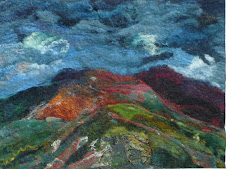

Today Enys and I picked 1.7 kilos of Dyers Chamomile from her garden where it grows better than in mine-why I don't know.
Dyers Chamomile is apparently a European plant that spreads as far as the Himalayas but was not much used in Europe as weld and sawwort were considered better dyes and this probably explains why, although Dominique Cardon1 has a section on the plant pigments found in Dyers Chamomile, she does not have a section of recipes, but nor does Jill Goodwin in the Dyers manual or Su Grierson in Colour Cauldron so maybe it also was not used or does not grow in Scotland or the North of England. John and Margaret Cannon in their lovely Kew Garden book with the beautiful illustrations -by the by one of my favourite and frequently turned to dye books- mentions that Dyers Chamomile was used to dye the Turkish carpets2 although Dominique Cardon says that this was the wild chamomile . Jenny Dean in Wild Colour 3has a page for dyers chamomile and also used the plant stem and leaves to get a soft green , something I must try this year.
All those who do talk about Dyers chamomile say that it is easy to grow which it is. You can often get it in garden centres as it is very pretty plant to have in the garden. It also dries extremely well with no apparent loss of pigment in the drying process but is considered to have a poorer light fastness than weld. My own light fastness tests were done a few years ago when I kept my samples for a year in in a north facing window when there was a significant loss of colour. Now I follow a more standard procedure mentioned on Natural Dyes Online and expose to light in a southwest facing skylight for a month with a standard indigo dyed sample alongside as a control. This I need to do this year .
I have been reading about the chemicals that give the dye colours in these plants. The general group the dye pigments come under is the Flavonoids and when these are dilute they are almost colourless. It is only when the molecules are clumped together or when they are bonded to metal ions that they appear yellow. A mordant therefore not only bonds the dye molecule to the fibre but is also essential in intensifying the colour and this would explain why John and Margeret Cannon commented that wool without a mordant was almost colourless.
Like so many dye plants dyers chamomile has a number of different plant pigments, Apigenin (which was the only pigment in wild chamomile) and is also found in weld, and luteolin also found in weld. Apigenin and luteolin are flavones. I mention weld as I wondered why when dyers chamomile shares at least two of the pigments found in weld which produces one of the most light fast yellows that dyers chamomile is not as light fast. Apparently according to Dominique Cardon from whom most of this information comes, this is because minor variations in the structure of the molecule is highly significant. The other pigments , according to Margaret and John Cannon in Dye plants and Dyeing are the flavonols quercetagetin, and one I can find nothing about, patuletin. The flavonals are more light sensitive. I went into all this because I was reading a paper about growing Weld (reseda Luteola) Dyers knotweed (polygonum tinctoria) and Dyers chamomile written by Anna Hartl and Christian Vogl ( The Potential use of Organically grown Dye Plants: experiences and results on cultivation and yields of Dyers chamomile, Dyer knotweed and Weld published in the Journal of Sustainable Agriculture 23(2) 2003. Here the author said that the main components of dyers chamomile had have not yet been identified,which I found most surprising and what started me off on reading my various books.
I can understand why Dyers chamomile would be considered as a source of yellows for the organic textile trade as it is easy to grow and apparently to harvest. Think how gorgeous fields full of dyers chamomile would look too so I hope that it does happen.
In the meantime I have put 200g of flower heads into soak ready to be a demonstration for members of the WI who are to visit the garden tomorrow.
(My footnotes with the titles of the books will not transfer over- why I don't know -sometimes blogging is so frustrating!)




































